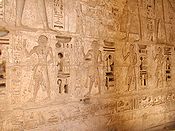.gif)
Amun-her-khepeshef (20th dynasty)
Encyclopedia

Ramesses III
Usimare Ramesses III was the second Pharaoh of the Twentieth Dynasty and is considered to be the last great New Kingdom king to wield any substantial authority over Egypt. He was the son of Setnakhte and Queen Tiy-Merenese. Ramesses III is believed to have reigned from March 1186 to April 1155 BCE...
. Like many of his brothers, he was named after a son of Ramesses II
Ramesses II
Ramesses II , referred to as Ramesses the Great, was the third Egyptian pharaoh of the Nineteenth dynasty. He is often regarded as the greatest, most celebrated, and most powerful pharaoh of the Egyptian Empire...
, Amun-her-khepeshef
Amun-her-khepeshef
Amun-her-khepeshef or Amonhirkhopshef or Amun-her-wenemef was the firstborn son of Pharaoh Ramesses II and Queen Nefertari.-Name:...
.
He died when he was about fifteen years old.
He is also mentioned as Ramesses Amun-her-khepeshef. He is not identical with his brother Ramesses VI
Ramesses VI
Ramesses VI was the fifth ruler of the Twentieth dynasty of Egypt who reigned from 1145 BC to 1137 BC and a son of Ramesses III by Iset Ta-Hemdjert...
, who was also called Amun-her-khepeshef before he became pharaoh.
He is depicted in his father's temple at Medinet Habu
Medinet Habu (temple)
Medinet Habu is the name commonly given to the Mortuary Temple of Ramesses III, an important New Kingdom period structure in the location of the same name on the West Bank of Luxor in Egypt...
. His well preserved tomb, QV55 (in the Valley of the Queens
Valley of the Queens
The Valley of the Queens is a place in Egypt where wives of Pharaohs were buried in ancient times. In ancient times, it was known as Ta-Set-Neferu, meaning –‘the place of the Children of the Pharaoh’, because along with the Queens of the 18th, 19th and 20th dynasties many princes and princesses...
) was excavated by Italian archaeologists in 1903-1904.

